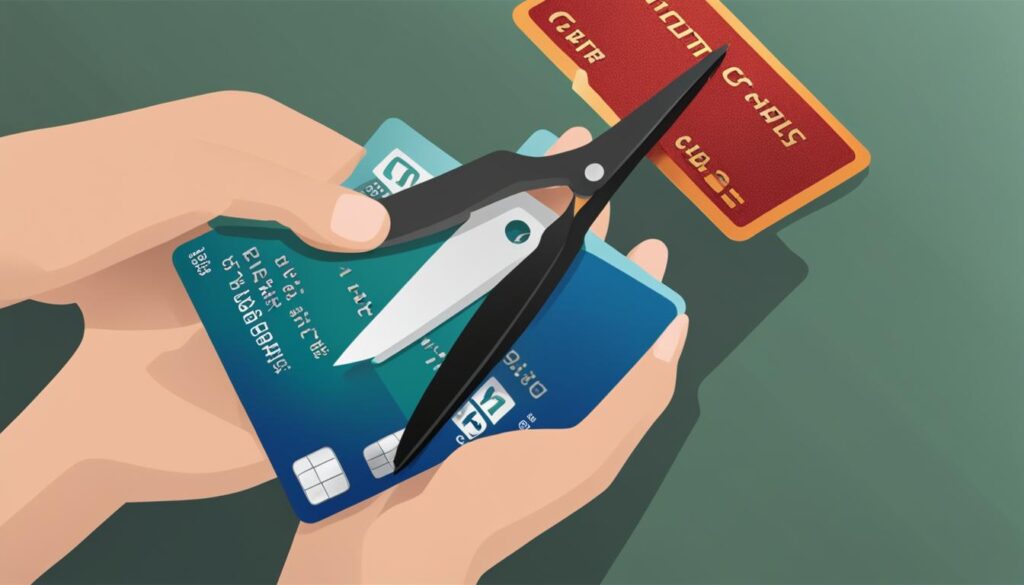Welcome to our guide on how to save money every day. If you’re into living frugally, finding budget hacks, and learning about finances, you’re in the right spot. We have 20 tips to help you save money each day and reach your money goals. Whether you’re clearing debt, saving more, or just wanting to live better financially, these tips will help your finances improve.
We’ll talk about making a budget, reducing debt, saving automatically, and smart shopping. You’ll learn various ways to mix these strategies into your daily life. By using these tips all the time, you’ll start saving money and feel secure in your finances.
Let’s get started and look at these tips to better your financial situation and hit your goals. It’s time to save more starting now!
Key Takeaways:
- Create a budget to track your income and expenses.
- Eliminate debt to save money and achieve financial freedom.
- Set a savings goal to stay motivated and focused.
- Automate your savings to make saving a priority.
- Save money by buying generic brands and meal planning.

Next, we’ll go deep into each saving tip and show how they can better your finance game.
Make a Budget
Creating a budget is a key way to save money. Make a budget lets you track what you earn and spend. This helps find where you can save more.
A budget gives a clear plan for your money goals. It keeps your spending in check. By following budgeting tips and staying true to your budget, you control your finances better.
To start, list all income and put your expenses into categories. Your expenses are either fixed like housing and bills, or variable like food and fun activities.
Setting Budgeting Goals
When make a budget, setting clear, attainable goals is crucial. Goals can be saving for a house, clearing debt, or starting a fund for emergencies. This helps you spend wisely and stay driven.
If you’re new to budgeting, adjusting your plan to find what’s best may take time. It’s important to be patient and keep at it.
Remember, budgeting is a personal finance management tool that empowers individuals to take control of their money and make intentional choices about how they spend and save.
Tips for Successful Budgeting
- Track your expenses: Keep a record of all your expenses to monitor your spending habits and identify areas where you can cut back.
- Set realistic limits: Be honest with yourself about your spending habits and set realistic spending limits for each category.
- Automate savings: Consider setting up automatic transfers from your checking account to a savings account to make saving a regular habit.
- Review and adjust: Regularly review your budget and make adjustments as needed. Life circumstances and financial goals can change, so your budget should be adaptable.
Following these budgeting tips and making budgeting a routine can help you reach your money goals. You’ll build a secure future for yourself.
Are you ready to manage your money? Below is a budget template you can start with:
| Expense Category | Planned Amount | Actual Amount |
|---|---|---|
| Rent/Mortgage | $1,500 | $1,500 |
| Utilities | $200 | $180 |
| Groceries | $300 | $275 |
| Transportation | $150 | $160 |
| Entertainment | $100 | $80 |
| Savings | $200 | $200 |
This is just a starting point. Adjust the template to match your income, spending, and financial dreams.
Say Goodbye to Debt
Getting rid of debt is key to financial freedom and a life without debts. If you have debts like credit card balances or personal loans, it feels like a heavy load. It stops you from reaching your financial dreams. But, by acting to remove debt, you get your finances back under control. This opens the door to a better financial future.
Eliminate Debt:
To fight debt, start by paying off the high-interest ones first. List all your debts and sort them by interest rates. Put extra money towards the one with the highest rate first. This cuts down the interest you pay and speeds up your debt-free journey. Keep doing this until all your debts are gone.
Debt-Free Living:
Being without debt brings peace and lets you grow your wealth. After clearing your debts, use the money saved from not paying interest for savings and investments. This builds a strong financial base. Now, you can work on big dreams like buying a house, starting a business, or enjoying a comfortable retirement.
Financial Freedom:
Letting go of debt leads to true financial freedom. Without debt, you can make life choices that fit your values and goals. Be it chasing your dream job, traveling the world, or spending time with family, being debt-free lets you live life your way. It helps create a better future for you and your family.

| Benefits of Being Debt-Free | Financially Restricted by Debt |
|---|---|
| Peace of mind | Constant stress and anxiety |
| Opportunity to save and invest | Living paycheck to paycheck |
| Ability to make choices based on personal goals | Feeling trapped and limited |
| Improved credit score | Difficulty obtaining loans or credit |
Set a Savings Goal
Setting a savings goal helps you control your financial future. Define a clear target, such as a down payment on a house, a dream vacation, or an emergency fund. This keeps you motivated towards long-term goals. Clear goals help you avoid spending on things you don’t need.
Make your savings goal realistic and achievable. Consider your income, expenses, and bills. Set up a plan with smaller milestones to feel progress. This will help you stay focused and happy on your journey.
Automating your savings can keep you on track. Set up an automatic transfer from your paycheck to a savings account. This ensures part of your income goes straight to your goal. This way, you won’t spend the money before saving it.
Saving is not just about money; it’s about security and achieving your dreams. Imagine how reaching your goal will feel, like the peace of having an emergency fund or the joy of a vacation. Keeping your goal in mind can motivate you and make saving rewarding.
Examples of Savings Goals
| Savings Goal | Timeline | Amount Needed |
|---|---|---|
| Down payment on a house | 3 years | $50,000 |
| Dream vacation | 1 year | $5,000 |
| Emergency fund | 6 months | $10,000 |
Having a savings goal gives direction to your financial path. It drives you to make wise choices and save for the future. Whether it’s for a big purchase or an emergency fund, setting a goal is key to financial success.

Save Money Automatically
Saving money is easier when you automate it. Setting up auto transfers from your paycheck to savings makes a difference. You save a part of your income effortlessly with this “pay yourself first” method. It makes saving your top priority.
Auto-saving stops you from spending that money early. It guarantees you regularly add to your savings. This method works well for any savings goal, like buying something special, setting aside emergency funds, or saving for retirement. Automating your savings keeps you on the right track.
Think about how much of your income you want to save. Starting with a small amount, like 10%, is a good idea. You can then slowly increase this as you get more comfortable. This adjustment helps you cope without stress.
“Automating your savings is like giving yourself a raise without ever seeing the money in your paycheck.”
Saving regularly helps you gather funds over time. It’s handy for both unexpected needs and future plans. Having savings gives you stability and peace.
Benefits of Automatic Savings:
- Consistency: You save money regularly, even when life gets busy.
- Financial Discipline: Making savings a priority teaches you to avoid unplanned spending.
- Compound Interest: Your savings can increase faster thanks to compound interest.
- Reaching Goals: It’s simpler to meet your financial dreams with automated savings.
Don’t wait to start this saving strategy. Begin auto-transfers now and pay yourself first. Watch your savings increase easily. Your future self will be grateful.

Buy Generic and Meal Plan
Two simple strategies can greatly impact your grocery budget: buy generic brands and plan your meals. These practices let you save money without losing out on quality or variety.
Save with Generic Brands
Generic brands are often overlooked but can save you a lot on groceries. They often match brand-name quality but cost less. Trying generic brands means enjoying great products while saving money.
“Buying generic brands instead of name brands can save you a significant amount of money.”
Always compare prices and read labels while shopping. You’ll find generic products have similar ingredients and taste as brand names. This ensures your choice to buy generic doesn’t hurt quality or taste.
Generic brands aren’t just for food. They cover items like cleaners, toiletries, and paper goods too. Savings extend to everyday essentials without compromising effectiveness.
Maximize Savings with Meal Planning
Meal planning is key to spending less on food. It stops extra trips to the store and cuts down food waste. Planning lets you shop only for what you need, avoiding extra spending.
Try to use what’s already in your pantry when planning meals. This reduces extra buys. Look out for sales to save even more and use leftovers wisely to lessen waste.
Meal planning also makes eating healthier easier. It helps you avoid costly fast food by preparing balanced meals and snacks ahead.
A Visual Representation: Grocery Savings
| Branded Products | Generic Brands | Meal Planning |
|---|---|---|
| Higher Price | Lower Price | Reduced Food Waste |
| Recognizable Brands | Comparable Quality | Healthier Choices |
| Impulse Purchases | Value for Money | Less Takeout Spending |
The table above shows how buying generic and meal planning saves on groceries. You spend less on products, reduce waste, and eat healthier. These habits lead to a smarter, budget-friendly grocery shopping routine.
So, consider generic brands and spending time to plan meals on your next shopping trip. These small steps mean big savings over time. This lets you stretch your budget further and reach financial goals.

Cut Expenses and Adjust Withholdings
To save more money, look at where you can cut costs. Reducing monthly expenses lets you save and invest more. Let’s explore some ways to reduce expenses:
1. Cancel Unnecessary Subscriptions
Look at your monthly subscriptions. Find any you don’t use or need. Canceling unused subscriptions like streaming services or gym memberships can save money. You could also combine subscriptions or choose free options to save even more.
2. Reduce Energy Costs
Make your home use less energy and lower your bills. Use LED bulbs, get a programmable thermostat, and seal leaks. Turning off lights and adjusting your thermostat when not in use can also cut costs.
3. Pack Your Lunch
Eating out can cost a lot and impact your budget. Save by packing lunch and cooking at home. This way, you spend less and eat healthier. Plan and cook meals in bulk to save time and money.
4. Find Ways to Lower Insurance Rates
Compare insurance rates for your home, car, and health. Many companies offer discounts for combining policies. Lowering your insurance premiums can greatly reduce your monthly expenses while keeping you well-covered.
| Expense Reduction Strategies | Impact |
|---|---|
| Canceling unnecessary subscriptions | Financial savings from unused services |
| Reducing energy costs | Lower utility bills |
| Packing your lunch | Cost savings from eating out |
| Finding ways to lower insurance rates | Reduced monthly insurance expenses |
Adjusting your tax withholdings is another way to cut costs. This can increase your take-home pay, leaving more for savings. Talk to a tax professional or use online tools to optimize your withholdings.

DIY and Avoid Impulse Purchases
To save money and spend wisely, start with do-it-yourself (DIY) projects and skip impulse buys. These steps help you manage money better and make choices that help you save.
Save on Home Improvements with DIY
DIY projects can cut your home improvement costs. Learn some basic skills instead of paying pros. You can paint, assemble furniture, fix leaks, or add shelves yourself.
“DIY projects not only save you money but also provide a sense of accomplishment and empowerment.”
Online tutorials and videos can teach you what you need to know. DIY work means you’re investing in your home and saving money at the same time.

Mindful Spending: Avoiding Impulse Purchases
Impulse buys can ruin your savings plans. To stop, think before you buy. Ask yourself if it’s necessary or fits your savings goals before purchasing.
If something catches your eye, wait a day before deciding. This wait helps you think more clearly about whether you truly need it.
Keep your savings goals in mind, especially when tempted to buy on a whim. Remembering your goals can help you avoid unnecessary purchases.
“Mindful spending helps you prioritize your expenses and make conscious choices that contribute to your long-term financial well-being.”
Take Advantage of Discounts and Rewards
Saving money is key, so always look for discounts and rewards. Many shops offer promotions that help you spend less. This means you can keep more money in your wallet.
Using discounts and coupons is a smart way to save. Look for coupons in newspapers, magazines, and online. They can cut costs on food, clothes, and gadgets. A few minutes of finding coupons can reduce your bill significantly.
Joining loyalty programs is another great saving tip. Stores offer these programs to give you points and special deals. When you shop and use your loyalty card or number, you gather rewards. These can be exchanged for discounts or free stuff later.
Don’t forget about cash-back apps. These apps give you money back on what you buy at certain stores. It’s like earning while shopping. By regularly using these apps, you save extra cash effortlessly.